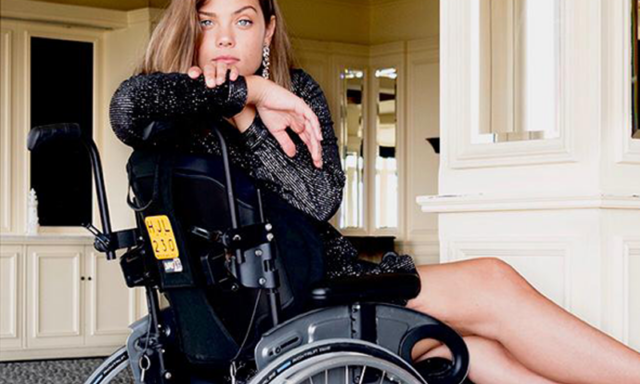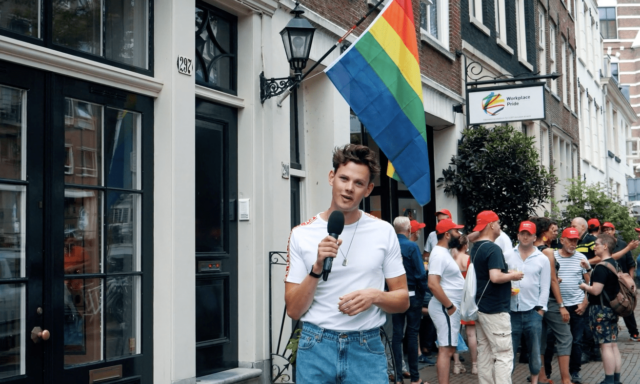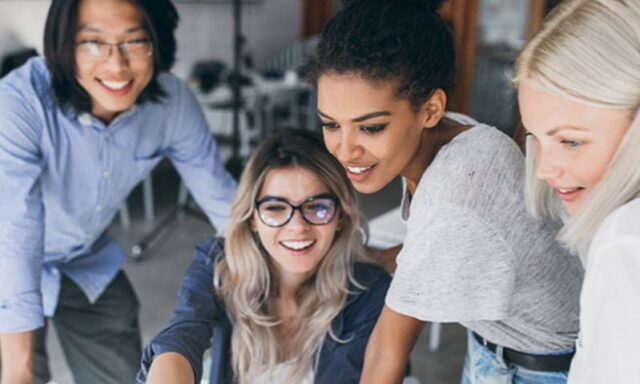Photo by: Désirée Hofland
Diversity is one of the most pressing issues of the moment, as global events bring injustice to the forefront, and companies seek to ensure they’re doing all they can to provide equal opportunities. During these conversations, it’s particularly important to hear from the affected people themselves: those who are personally impacted by corporate policies, whether positively or negatively, and to get a first-hand perspective on what further support should be provided.
Meet Julia Brouwers, who is on a mission to help make workplaces more inclusive. The former professional athlete has a personal reason behind her dedication to the cause: Brouwers has a disability herself, and so has experienced first-hand the unique struggles – and benefits – that come with this. She now works for a large beauty brand and is very happy in her job, but she has also faced significant challenges within the job market. We spoke to Brouwers to hear her memorable and inspiring story, and to get her perspective on diversity practices that companies should implement.
As a young teenager, Brouwers was swimming at a professional level and holding the title of Dutch National Relay Champion. Then from one day to the next, Brouwers could no longer feel or move her legs. Seven years – and multiple false diagnoses – later, Brouwers was diagnosed with a connective tissue disorder. She now uses a wheelchair and a walker to get around. Brouwers says that the self-discipline she honed as a professional athlete helped her adjust to her new normal, but naturally, her journey has had its ups and downs.
After finishing high school, Brouwers wanted to continue studying, but her connective tissue disorder meant that she spent a lot of time at the doctor. “I also used to be in bed full-time, which made it difficult to participate in life like everyone else,” explains Brouwers. She found a coaching program that suited her, and through her studies discovered that her passion was helping other people.
A couple of years ago, Brouwers started looking for a job. “I found the process of job hunting super intriguing,” she says. Why was that? “On the inside, I’m just like everyone else, but when you’re sitting in a wheelchair, all of a sudden people see you differently,” explains Brouwers. “When I’m using my walker, people don’t really see me for who I am: they just see me as a girl with a disability. You’re placed in a box.”
The challenges of job-hunting for people with disability
Brouwers found the process of looking for a job both challenging and frustrating. “People focused too much on my disability,” she says. “Some companies were afraid that my disability would be an issue – I look okay, but sometimes I have to do things in my own way, which can be scary for the company as well as for the person with the disability.” At first, companies tend to be strict on their policies, especially at the interview stage. Diversity starts for companies with recruitment and their hiring process.
In interviews, Brouwers would ask if she could work at home on occasion, to save her the exhausting commute into the office. “That was very difficult for me, because sometimes with a disease like mine, it’s needed,” she explains. “Sometimes, I’ll wake up and won’t feel well enough to do all the traveling that’s required with going to work. Other days, I’m okay and I can do that.” Without an understanding of the reality of living with a disability, it was sometimes difficult for companies to understand why she – and others with disabilities – might need slightly different rules from other employees.
Eventually, Brouwers found a job that she loved, and it opened her eyes: “I saw that it really can work out if you don’t give up,” she says. Contrary to the idea that hiring a person with a disability just means adjusting your workplace and adding in ramps and accessible features, the advantages of a diverse workforce are far-reaching. “It can be a huge benefit to hire someone who has a disability,” says Brouwers. “When you have a disability, you have to think differently, which also means you can come up with ideas that others in your team would never come up with. It brings a nice dynamic to teams.”
Another consideration that arose for Brouwers during her job hunting was whether she should mention her disability or not. It’s important to remember that while Brouwers has spoken with a range of other people with disabilities to share experiences, each person is different, and will have different levels of comfort. Brouwers considers herself an open person, so was happy to bring up her disability in job interviews. “You walk in with a walker, or you’re in a wheelchair, and obviously they can see that something’s going on,” she says. “I started the conversation myself, saying ‘hey, there’s one thing you need to know… It means I’ll sometimes feel very good and sometimes feel a bit worse, but I’ll always try my best to get the job done.”
And while everyone needs to prove themselves to a degree during a job interview, Brouwers feels that for those with a disability, proving themselves becomes all the more important. “I’m okay with that because I have the energy to prove myself, but I know that a lot of people with disabilities don’t have that energy,” she points out. “I’ve really seen that once I proved myself at my job, people have a lot more faith in me, and gave me way more encouragement – because the trust had been built.”
Effecting positive change
A little while ago, Brouwers decided to write a LinkedIn post about the difficulties that people with disabilities face when job-hunting and showing her appreciation to her current employer. The post went viral and has been viewed by almost 1.4 million people. “I thought, maybe other people can be inspired by my story, and decide to be a little more open-minded,” says Brouwers. She wants others with disabilities to find jobs they love, and realise that their disability can be an asset in the workplace. For that to happen, employers must ensure they are as accessible as possible and have policies in place that allow people with disabilities to thrive within the company. “It’s important to create awareness and share more good, positive stories on hiring people with a disability,” notes Brouwers.
When it comes to what Brouwers wished had happened differently during her job hunt, she says it all starts with understanding. When going for a job interview at an office you’ve never visited before, it’s important that the prospective candidate knows the building is accessible. Something as simple as asking the candidate if they need additional assistance can go a long way. Brouwers says that on occasion, she felt left out, or treated differently than other candidates.
“It’s also weird sometimes going for a job interview in the middle of an office, and seeing that you’re the only person in a wheelchair,” explains Brouwers. “It’s often hard for people to understand what it’s like when they’ve never hired someone in a wheelchair before. I once even went for a job interview where I was told ‘we’re going to take the stairs here’, and I had to reply, ‘well, I can’t take the stairs, obviously.’”
For Brouwers, it’s also important to consider a candidate’s disability in a positive light, focusing on the value they can bring to the company. “It would have been lovely to be asked that, because then I could have right away displayed my strengths and discipline. It’s very important to focus on your strengths,” says Brouwers.
To help advance her goal of creating a culture of openness surrounding disabilities, Brouwers recently joined her employer’s diversity team. “That showed me how important it is to have people with disabilities in these groups as well, because they’re often left out,” explains Brouwers. “We focus on race, ethnicity, gender, and age, which are all super important – but so are disabled people.” People with disabilities face unique challenges in the workplace, and it’s difficult for others to appreciate what it’s like to face these challenges on a daily basis. “You don’t really think about wheelchair accessibility when you’re not in a wheelchair, because you don’t have to think about it,” points out Brouwers. “That’s also how I used to think! But not that I’m confronted with it, it opened my eyes.”
How companies can become more accessible
Start with your recruitment process
Brouwers says that bringing about positive change and making companies more disability-friendly starts with recruitment. The team needs to be aware of what they’re looking for, and which exceptions they can make for the right candidate. “If a woman with a child is applying, it’s likely that they’re allowed to start a bit later so they can first drop off their kid,” says Brouwers. “It’s exactly the same for a person with a disability: if they can start a bit later sometimes, they can sleep well and start the day fresh. It’s the same thinking, but people with disabilities are often forgotten.”
Ensure your building is fully accessible
Brouwers points out that it’s necessary to cover the basics: an elevator that can fit a wheelchair, and a disabled toilet. “Don’t invite someone in a wheelchair, and then say, ‘oh sorry, we only have stairs’! That’s really important,” says Brouwers.
Be open and flexible
“Don’t be afraid to have an open conversation,” advises Brouwers. “Most people that I know who have a disability are open about it, and just want to be treated like everyone else, and with a little more understanding.” For some people, flexible hours would be helpful. “Not every week is going to be the same,” says Brouwers. “Some days you feel very energetic and healthy, and on other days, you’re a little more tired. More and more companies are trying to be flexible with this, which is really great!” Brouwers also points out that talking about disabilities doesn’t have to be taboo. Talking about the individual experience can help employees feel more understood, and as if their employer is doing their best to understand how they can help.
Appoint a dedicated liaison person
Brouwers recommends companies appoint a liaison person who employees can talk to if something is going on that might affect their work. “This would make people more comfortable saying, ‘hey today I’m starting late, so tomorrow I’ll work an extra hour’,” says Brouwers. “And once you’ve appointed that person, make sure people know about them!”
Talk to other companies
Brouwers acknowledges that it can be difficult for companies to start the process of making their workplace more accessible. “It’s a good start to talk to companies that help people with disabilities, and those who actually have knowledge about this topic,” advises Brouwers. “Talk to disabled people themselves to see what they need! A lot of companies say they tried their best, but they didn’t get any diverse applicants,” but it’s a question of trying a bit harder.
Moving forward after the pandemic
Brouwers thinks that the COVID-19 pandemic has brought a benefit for those with disabilities: companies now see how easy it is for employees to work from home. This positive side-effect, alongside the general trend of companies focusing their efforts on diversity, means that Brouwers is positive about what the future holds. Hiring people with disabilities involves open lines of communication so that all parties feel heard, and that solutions can be reached together. “You don’t have to assume that hiring someone with a disability is more complicated,” notes Brouwers. “That’s my vision: to create more openness.”
Do you feel as inspired by Julia’s story as we do? Then let’s catch up and see how we can help your team grow stronger and be more diversified.





